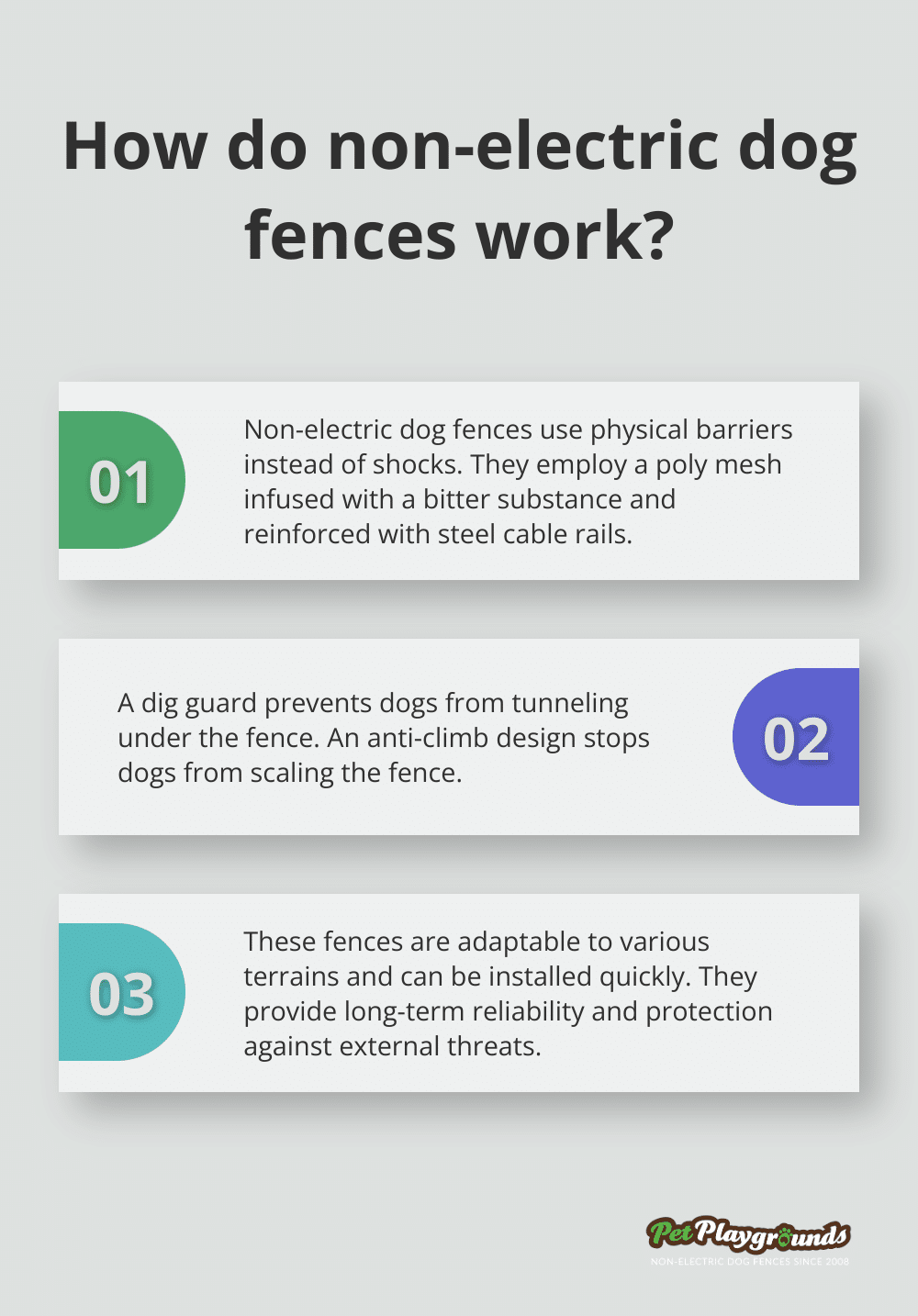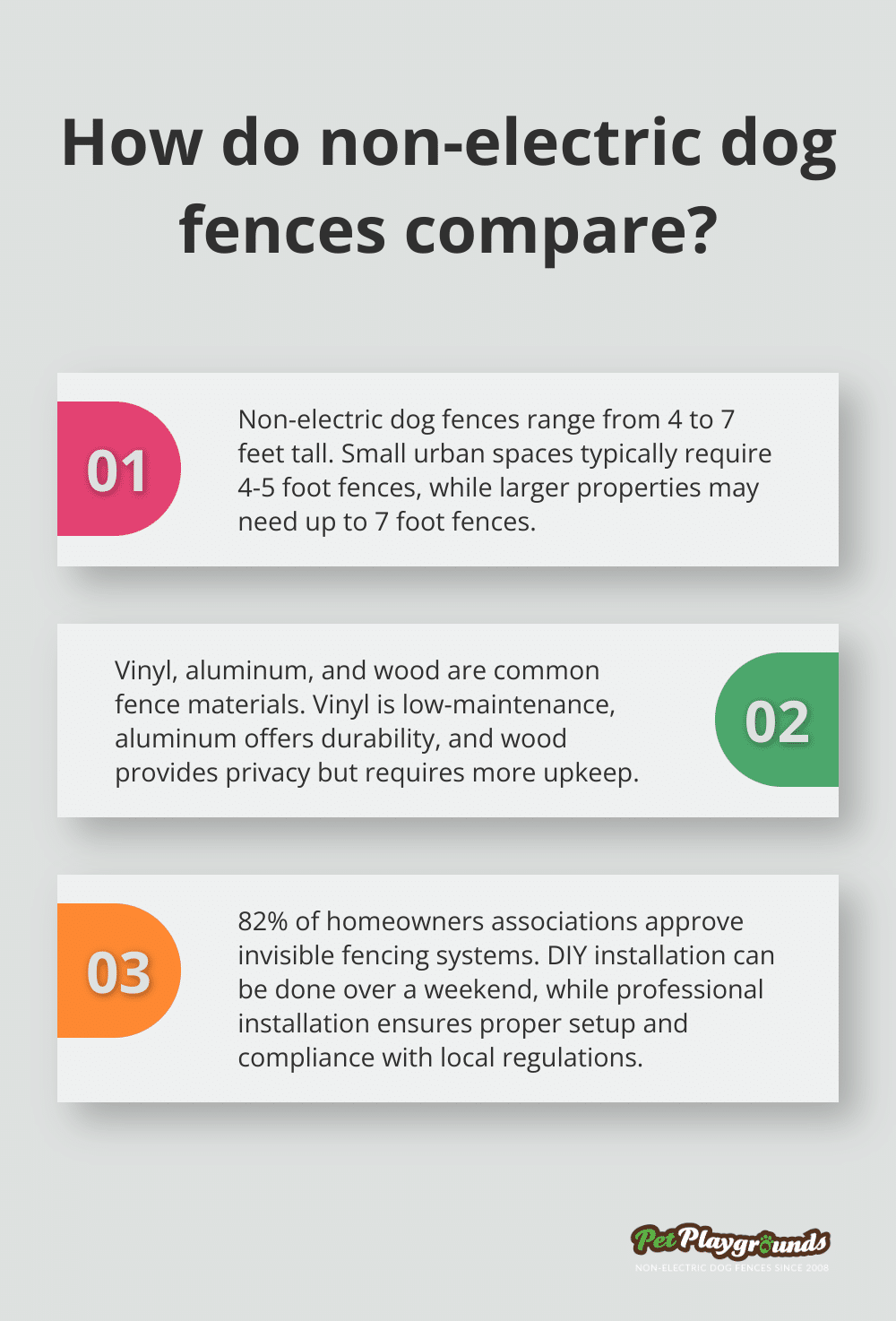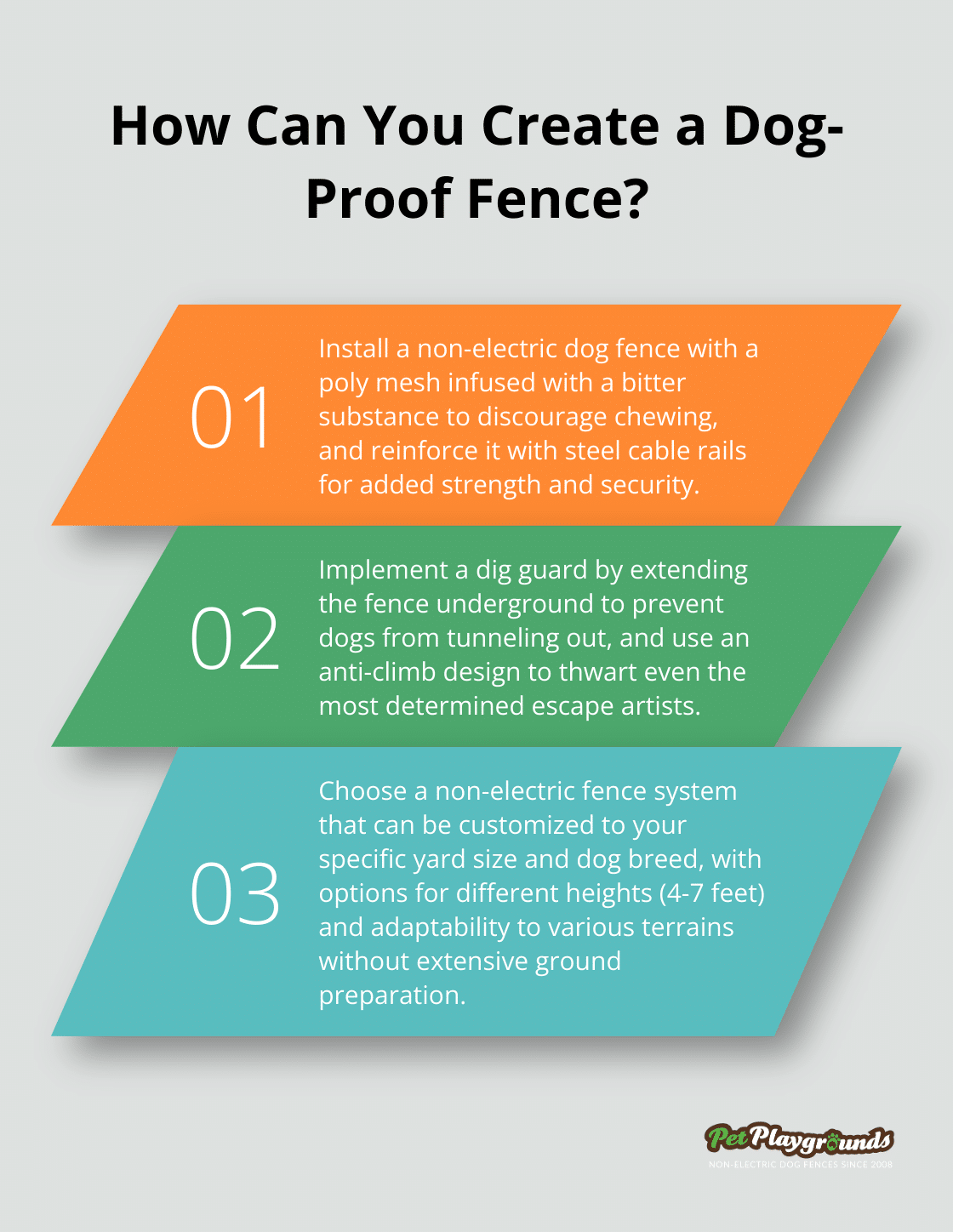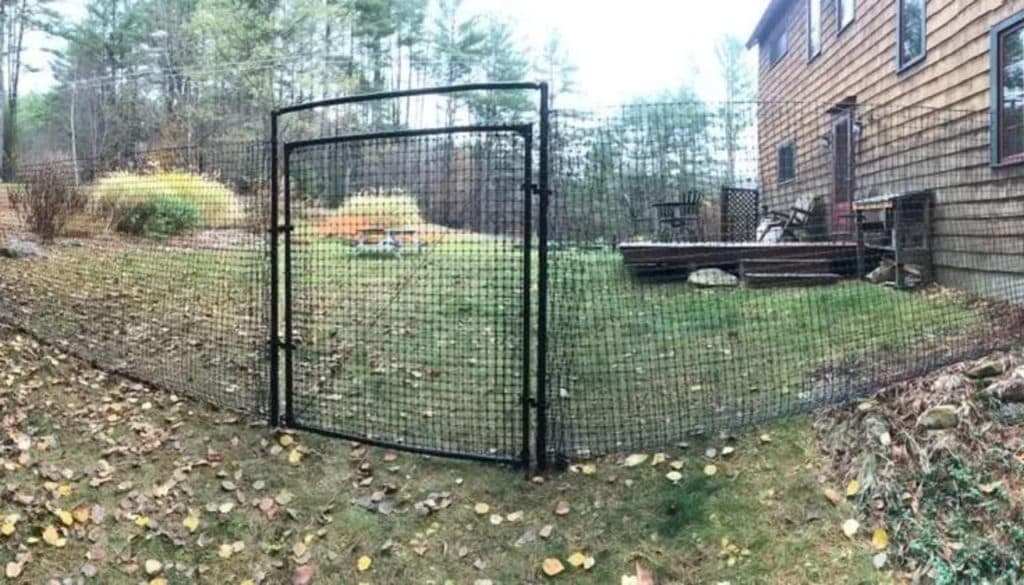Are you tired of worrying about your dog’s safety in the yard? A non-electric fence might be the solution you’re looking for.
At Pet Playgrounds Non-Electric Dog Fence, we understand the importance of keeping your furry friends secure without compromising on aesthetics or safety. Our innovative fencing system offers a humane and effective alternative to traditional electric barriers.
In this post, we’ll explore the benefits of non-electric fences and help you determine if they’re the right choice for your property in 2025.
How Non-Electric Dog Fences Keep Pets Safe
The Mechanics of Non-Electric Fencing
Non-electric dog fences revolutionize pet containment by offering a humane and effective alternative to traditional electric systems. These innovative fences use physical barriers and clever design elements to keep dogs secure without relying on shocks or other aversive methods.

The foundation of a non-electric dog fence system typically employs a multi-layered approach to security. A robust poly mesh (often infused with a non-toxic, bitter substance to discourage chewing) forms the primary barrier. Steel cable rails reinforce this mesh, providing strength while maintaining a low visual profile. The combination creates a formidable yet aesthetically pleasing barrier.
Key Components for Maximum Security
A critical feature of many non-electric systems is the dig guard. This underground extension prevents dogs from tunneling their way to freedom, addressing a common escape route that many traditional fences overlook. Additionally, an anti-climb design thwarts even the most determined canine escape artists, ensuring that pets remain safely within the designated area.
Non-Electric vs. Electric: A Safety Comparison
While electric fences rely on shock collars to create invisible boundaries, non-electric systems offer tangible barriers without the risk of physical harm or psychological stress to pets. Positive reinforcement has been shown to be more effective at training dogs than electronic collars, which can have risks for animal welfare.
Adaptability and Installation Ease
Non-electric fences excel in their adaptability to various terrains. Many systems can be installed without extensive ground preparation, conforming to the natural contours of a property. This flexibility not only preserves the landscape but also allows for quicker installation compared to traditional fencing methods.
Long-Term Benefits and Peace of Mind
The durability of non-electric fences translates to long-term reliability. With proper maintenance, these systems can provide years of worry-free containment. Moreover, they offer protection not just for keeping dogs in but also for keeping potential threats out-a feature that invisible electric fences cannot match.
As we consider the various options available for pet containment, it’s essential to evaluate the specific needs of your yard and your furry companions. Let’s explore the benefits of non-electric dog fences in more detail to help you make an informed decision.
Why Non-Electric Dog Fences Are Game-Changers
Uncompromising Safety for All
Non-electric dog fences revolutionize pet containment by prioritizing safety. These systems create physical barriers without the risk of harm to pets or family members, eliminating concerns about collar malfunctions or potential psychological stress in dogs. Studies show that aversive methods can cause stress in dogs, which aligns with the principles of non-electric fences. Your furry friend can enjoy the outdoors without the anxiety often associated with invisible boundaries.
Preserving Your Landscape’s Beauty
Non-electric dog fences blend seamlessly with existing landscapes, a significant advantage over traditional fencing that can disrupt a yard’s natural beauty. These systems maintain the aesthetic appeal of your property while preserving scenic views. This feature proves particularly valuable for homeowners who have invested in landscaping or those living in areas with strict homeowners’ association guidelines. The Community Associations Institute reports that 82% of HOAs approve invisible fencing systems, making non-electric options versatile choices for various neighborhoods.
Built to Last with Minimal Upkeep
The durability of non-electric dog fences contributes to their growing popularity. High-quality materials (such as robust poly mesh and steel cable rails) offer superior strength compared to traditional wooden or chain-link alternatives. This longevity translates to less frequent replacements and repairs, saving money over time and ensuring consistent protection for pets.

Low maintenance requirements allow you to spend more time enjoying your yard with your dog and less time worrying about fence upkeep. Non-electric fences also eliminate the need for battery replacements or concerns about power outages affecting the system’s functionality. This reliability proves essential for pet owners who prioritize consistent security for their furry companions.
Weather-Resistant Performance
Non-electric fences excel in areas prone to extreme weather conditions. While traditional fences may suffer damage from storms or require regular painting and staining, non-electric systems remain steadfast with minimal intervention. This resilience ensures year-round protection for your pets, regardless of the weather.
Customizable Solutions for Every Yard
Non-electric dog fence systems offer flexibility to accommodate various property sizes and shapes. From small urban backyards to sprawling rural properties, these fences adapt to meet specific needs. Many systems (like Pet Playgrounds Non-Electric Dog Fence) provide options for different dog breeds and sizes, ensuring a tailored solution for your pet’s unique requirements.
As we explore the process of selecting the right non-electric dog fence for your property, it’s important to consider factors such as yard size, dog behavior, and installation preferences. Let’s examine how to choose the perfect system for your needs.
How to Select the Perfect Non-Electric Dog Fence
Assess Your Yard and Dog
The selection of an ideal non-electric dog fence starts with an evaluation of your property and pet. Yard size determines the appropriate system. Small urban spaces often require fences 4 to 5 feet tall, while larger properties may need fences up to 7 feet high for effective containment.

Dog breed and behavior also influence fence choice. High-energy breeds or those with strong prey drives need robust fencing solutions. The American Kennel Club suggests examining your dog’s jumping and digging tendencies. The safety of your dog and home depends on a pre-winter deep clean, as dust, dirt, dander, and dog hair can build up in out-of-sight places.
Explore Fence Types
Non-electric dog fences come in various materials and designs. Vinyl panel fencing is easy to maintain, making it a busy homeowner’s dream. It offers dense, solid protection around your yard that keeps out unwanted visitors.
Aluminum slat fences provide excellent durability and a modern aesthetic (though they can be more expensive and may not suit all landscapes). Wood fences remain popular, offering privacy and a classic look, but require more maintenance and can suffer weather damage over time.
Consider Installation Options
You have two main installation choices: DIY or professional. DIY kits can reduce costs and provide a sense of accomplishment. Many homeowners successfully install their own fencing over a weekend. This approach requires careful planning and physical effort.
Professional installation ensures proper setup and benefits complex landscapes or large properties. Experts navigate tricky terrain and ensure compliance with local regulations. The Community Associations Institute reports that 82% of homeowners associations approve invisible fencing systems, but you should check your specific HOA rules before installation.
Look for Customization Features
The best non-electric dog fences offer customization options to meet specific needs. Search for systems that allow height and configuration adjustments. Some advanced options include removable sections for easy lawn maintenance or temporary access.
Adaptability to your landscape stands as another key factor. Fences that conform to natural contours without extensive ground preparation preserve yard beauty while providing effective containment. This feature proves particularly valuable for properties with slopes, trees, or other natural obstacles.
Prioritize Long-Term Value
When selecting a non-electric dog fence, consider the long-term value. Durable materials resist wear and tear, reducing the need for frequent replacements. A well-chosen fence should provide years of reliable service, justifying the initial investment.
Try to find a system that offers flexibility for future changes. Your needs may evolve as your dog ages or if you add more pets to your family. A fence that allows for easy expansion or modification will serve you well in the long run.
Final Thoughts
Non-electric dog fences offer a revolutionary solution for pet owners who prioritize safety and aesthetics. These systems provide uncompromising security without the need for shock-based containment, allowing dogs to enjoy outdoor spaces safely. The versatility of non-electric fences accommodates various property types and pet requirements, making them an excellent choice for many homeowners.
Pet Playgrounds Non-Electric Dog Fence stands out as a premium option that combines safety, aesthetics, and durability. This system features Bitter Pro-infused poly mesh, steel cable rails, and a dig guard to ensure comprehensive protection for your furry friends. Its adaptability to existing landscapes and straightforward installation process make it an attractive choice for creating a secure outdoor environment.

As we approach 2025, non-electric fences represent a forward-thinking choice for responsible pet owners. These fences enhance a dog’s quality of life and create a safe haven for outdoor enjoyment (without compromising on style or effectiveness). Consider exploring the options available to transform your yard into a secure and inviting space for your beloved canine companions.
























